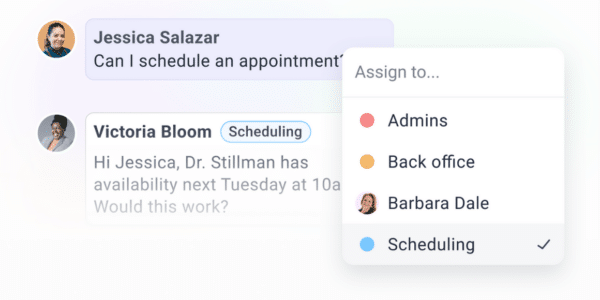Patient experience best practices are what we, in healthcare, are always seeking out. Making the care process more accessible, enjoyable, and comfortable are frequently topics of discussion for healthcare providers and staff. With emerging options for care that the patient can choose from, we must strive for the best experience whether it is virtual or in-person. As you explore new options for care and uncover how they fit in your healthcare organization, learning from others who have been through it is fundamental. In a recent episode of “The Patient Experience”, OhMD CEO, Ethan Bechtel, sat down with Vice President of Integrated Spine and Joint Institution, Urooj Ansari, to discuss the patient experience best practices that helped make her pain management practice so successful.
Patient experience best practices to use today
1. Ensure in-person and virtual safety
As COVID-19 continues to shift the process of healthcare, ensuring the safety of visits is crucial. Many of Ansari’s patients actually ask to come into the office because they feel safe and comfortable. This is due to the organization’s continuity of safety protocols and having staff that cares. They’ll have a positive association with office visits. “You know you’ve done something special when patients want to come in,” said Bechtel regarding Integrated Spine & Joint Institute’s patients’ willingness for in person visits despite the pandemic.
Today, virtual visits becoming more frequent and, in many cases, in-person visits are less feasible or convenient. In these situations patients need to have trust that their information is safe. As a care team you must confirm that your telehealth tools are HIPAA compliant to protect yourself, your organization, and most importantly, your patients. Choose virtual care tools give patients security options. For example, OhMD offers providers and patients the ability to text directly through SMS or to send messages via encrypted link.
While convenience and ease of access in virtual care is critical for patients, also take time to make sure they know their data is safe and inform them that they are using a secure and HIPAA compliant software for telehealth appointments.
2. Simplify the communication between patient and provider
With much of the uncertainty that accompanied COVID-19, patients want to feel confident in their provider. By improving communication, healthcare visits will become a lot less stressful for the patient and provider. Providers can leverage simple communication tools such as texting or webchat so that patients understand expectations going into an appointment. Patients want to know they are interacting with real people, so talk to them like it.
Eliminate barriers such as patient portals that require a login to access care.
Wave good-bye to automated calls where the patient can’t actually connect with a real person.
Use the tools your patients already use everyday for more effective communication and higher patient satisfaction.
One of the best patient experience best practices we can offer is to be present as it not only improves communication but it creates a personal relationship between the patient and practice. Where you can, opt for solutions that allow real people to interact. Simple switches like foregoing automated or voice recognition call systems and opting for text messaging and live webchat on your site can not only save you time and money, but can also greatly improve your connection with patients.
3. Build a personal relationship – a critical patient relationship best practice
Relationships take time and effort. You don’t have a single conversation with someone and then trust them like you would a family member or close friend. Healthcare is no different.
Take the time to get to know your patients on a personal level.
Make sure they feel comfortable with you.
Become a trusted person in their life.
Your interactions with your patients are what fuels the decision to continue coming back or opting for another care provider. Ansari, offering one of her top patient experience best practices, noted that she and her staff work to build strong connections with their patients. This effort makes each meeting special for their clientele. For patients of Integrated Spine & Joint Institute, knowing the doctor is there for them every step of the way brings a level of comfort and trust. They alleviate fear, pain and negativity that can sometimes be associated with diagnosis and care. An act as simple as checking in after an appointment can greatly strengthen the patient provider relationship.
4. Empower a pleasant staff
You can’t always control every aspect of the visit and every person the patient engages with. While it is important to have personal relationships between patients, care teams should work hand-in-hand to improve and work towards a positive patient experience. Studies reveal there is value in measuring the effectiveness of care and the satisfaction of patients based on interactions across the care team rather than individual providers. Be sure these expectations are set with your staff.
The best practice is to work as a unit with the goal revolving around the patient experience.
Make sure your staff has bought into your plans and methodology for patient experience best practices. For many, this is putting added emphasis on patient-centered care and patient engagement. Allow for further medical education for your staff regarding patient care studies and analytics. Providing your staff learning opportunities and understanding of why patient experience is so important will pay dividends. Happy patients helps to improve employee satisfaction and, in turn, quality of care. Patient experience best practices should be at the root of your employee culture.
5. The ultimate patient experience best practice – Make healthcare a simple process
Healthcare is hard. It can be stressful for providers and patients alike. Like Bechtel shares, there are very few trips to the doctor that are truly enjoyable.
Alleviate some of that stress by making the care process as simple and accessible as possible.
Offering efficient scheduling, shorter wait times, and the ability to quickly connect in meaningful ways will further patient satisfaction. This may include automated appointment reminders through HIPAA compliant text messaging, digitized patient intake forms, or a host of other aspects of the virtual care journey.
The process for in-office visits should be just as efficient. Have established, well-documented, check-in processes and make your visitors aware of safety protocols in advance. Keeping patients at ease entering and leaving the office is highly effective and easy to implement with the right messaging tools.
Patients should feel like a priority in the care process.
Bonus best practice: Improve patient satisfaction with reviews and feedback
Learn from your patients through reviews and feedback to improve patient retention and patient satisfaction. Just like how healthcare providers can further their education around best practices, this educational information can come directly from your patients. Use reviews to gain important feedback and improve patient experience scores on your website.
OhMD’s Autopilot feature allows you to gain thoughtful insight into how to make the patient experience the best it can be. When a patient texts in the keyword “review”, Autopilot automates a prompt asking them to take a patient experience survey with scores between one and ten. From there, they will be taken directly to your reviews site to leave important feedback. They will be able to leave a review directly from their phone.
This feedback will ultimately let you know how to improve patients experience, but may also give you validation with your best practices. When your practice is focusing on patient centered care, your reviews will reflect that.
These are just a few of the many patient experience best practices we’ve learned from the truly remarkable organizations we’ve worked with. Improving patient satisfaction is continuously evolving with studies and data providing proof points as to how to be most effective. Make the patient experience more enjoyable and ensure they always turn to you for care.


